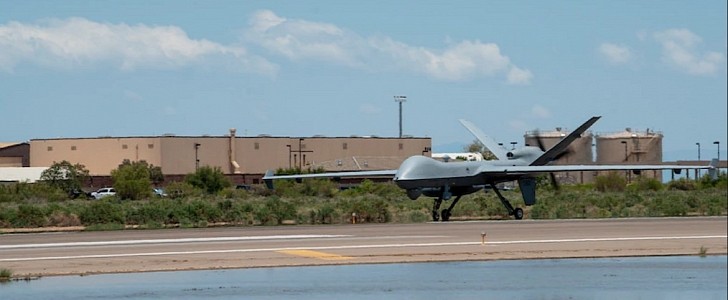Previously, all MQ-9 Reaper Drones take-offs and landings required a specialized launch and recovery crew located wherever the Reaper intended to land. Now, the U.S. Air Force has demonstrated that the aircraft can do that all on its own, all thanks to its new Automatic Takeoff and Landing Capability (ATLC) capability.
The Reaper (named Predator B when it is equipped with weapons) is classified as a Remotely Piloted Aircraft (RPA). While it can already operate autonomously up in the air, the new ATCL capability also allows it to take-off and land on its own. Initially, pilots had to electronically designate reference points after the MQ-9 arrived at the airfield of operation and taxied down the runway.
Using the new technology, the U.S. Air Force demonstrated that a specialized infrastructure is no longer needed. The 556th Test and Evaluation Squadron recently proved that by landing an MQ-9 equipped with ATLC at Creech Air Force Base (AFB) while under satellite control from Nellis AFB crews.
The team put the new tech to the test on two different days. On the first day, the Reaper taxied to the runway and took off from the Creech AFB in Nevada, 55.6 miles (89 km) away from the crew that was controlling it.
It flew to the Cannon AFB, New Mexico, where it landed, taxied, then took off again before returning to the Creech AFB, all while being under satellite control. In this case, the pilots used imagery in the cockpit to construct the automatic landing system's reference points.
On the second day, the crew flew the Reaper to Holloman AFB in New Mexico, where they demonstrated the ATLC capability once more. This test made use of the targeting pod to survey the runway and provide the ATLC system with the data necessary to fly an airport traffic pattern.
This new feature tested by the Air Force is crucial in enabling the MQ-9 agile combat employment. Together with the drones' next software upgrade and delivery of the portable aircraft control station, it will transform how it is used in theaters across the world.
Using the new technology, the U.S. Air Force demonstrated that a specialized infrastructure is no longer needed. The 556th Test and Evaluation Squadron recently proved that by landing an MQ-9 equipped with ATLC at Creech Air Force Base (AFB) while under satellite control from Nellis AFB crews.
The team put the new tech to the test on two different days. On the first day, the Reaper taxied to the runway and took off from the Creech AFB in Nevada, 55.6 miles (89 km) away from the crew that was controlling it.
It flew to the Cannon AFB, New Mexico, where it landed, taxied, then took off again before returning to the Creech AFB, all while being under satellite control. In this case, the pilots used imagery in the cockpit to construct the automatic landing system's reference points.
On the second day, the crew flew the Reaper to Holloman AFB in New Mexico, where they demonstrated the ATLC capability once more. This test made use of the targeting pod to survey the runway and provide the ATLC system with the data necessary to fly an airport traffic pattern.
This new feature tested by the Air Force is crucial in enabling the MQ-9 agile combat employment. Together with the drones' next software upgrade and delivery of the portable aircraft control station, it will transform how it is used in theaters across the world.






